Upgrading Your Windows XP Skills to MCSA Windows 8.1 v6.1
Question 1
Your company has a main office and two branch offices named Branch1 and Branch2. The main office contains a file server named Server1 that has BranchCache enabled. Branch1 contains a server named Server2 that is configured as a hosted cache server.
All client computers run Windows 8.1 Enterprise. All of the computers are joined to an
Active Directory domain.
The BranchCache settings of all the computers are configured as shown in the following exhibit. (Click the Exhibit button.)
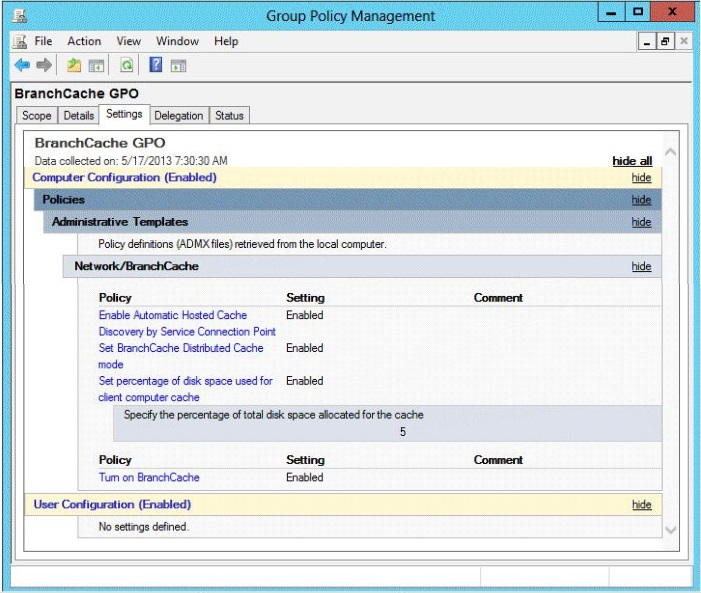
In the table below, identify the effective setting for the client computers in each branch office. Make one selection in each column. Each correct selection is worth one point.
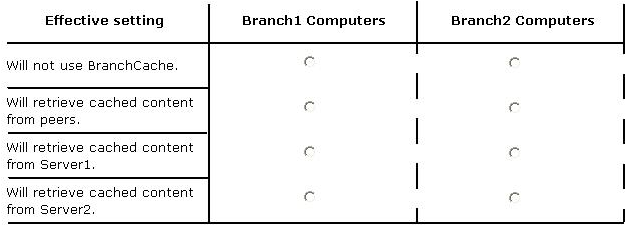
Answer : 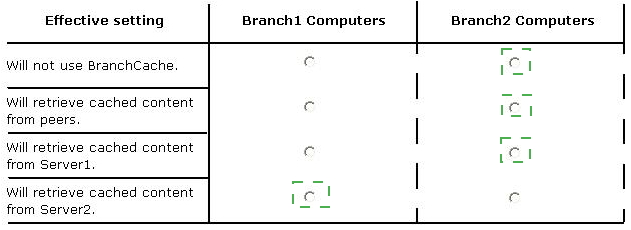
Explanation:
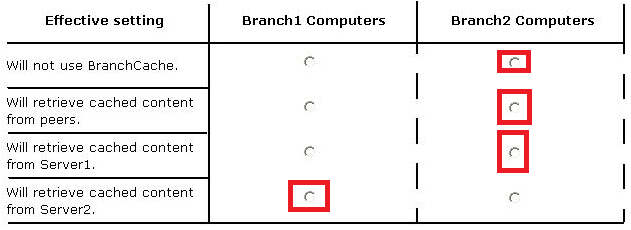
Question 2
You are the network administrator for Contoso.com and are creating an image for a
Windows 8.1 implementation for all of your users.
You find out that an application your company has used for many years is not compatible with Windows 8.1. It has always worked on your Vista computers with SP2. The application requires administrator privileges.
You need to configure the correct settings so that the application can run on Windows 8.
Which two actions should you perform? (Each correct answer presents part of the solution.
Choose two.)
- A. Select Run this program as an administrator in the Compatibility Troubleshooter.
- B. Assign the application to Run as administrator on the Security tab of the application executable file properties.
- C. Modify the User Account Control Settings by adjusting the slider to Never Notify.
- D. Using the Compatibility Troubleshooter, check Run this application in compatibility mode for and select Vista (Service Pack 2).
- E. Using the Application Compatibility toolkit, run the Windows Vista Compatibility Evaluator for Windows 8, and select the Service Pack 2 option.
Answer : D,E
Explanation:
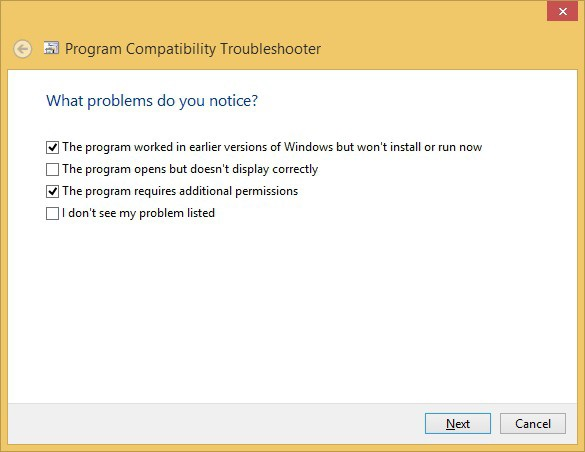
C:\Users\Chaudhry\Desktop\1.jpg -
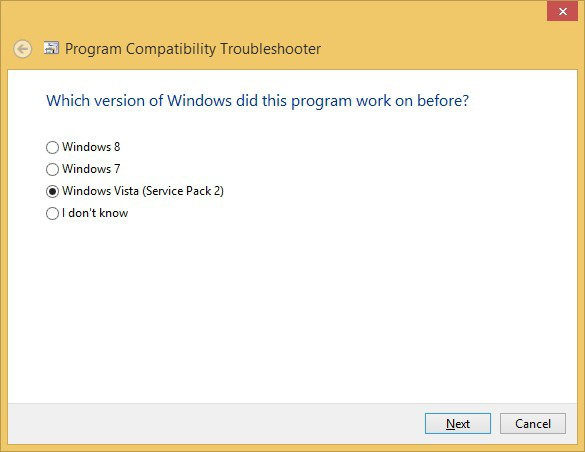
C:\Users\Chaudhry\Desktop\1.jpg -
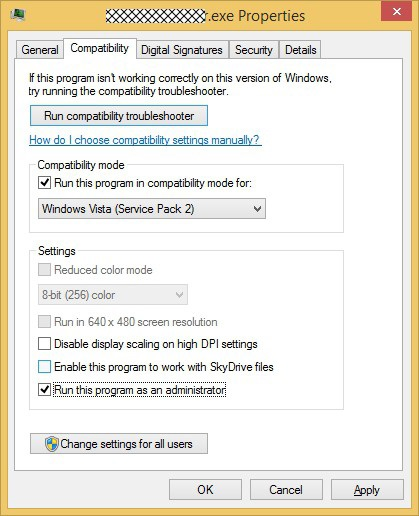
C:\Users\Chaudhry\Desktop\1.jpg -
Question 3
You are the desktop administrator for your company, which uses Windows 8.1 computers.
The company decides to use virtual disks at your location so the programmers can build and test applications in a closed network.
You need to use the file given as a virtual hard disk and be able to boot to the vhd.
What should you do?
- A. Move the vhd file to a network share, map the network share, and allow a network boot.
- B. Attach the vhd in computer management and add it to the Boot Menu.
- C. Copy the vhd file to the root of C:\ open msconfig, and choose Safe Boot and Alternate Shell.
- D. Copy the vhd file to the root of C:\ run bcdedit and add an entry to the boot options that includes the path to the vhd.
Answer : D
Question 4
You have client Windows 8.1 Enterprise computers.
Your company purchases a subscription to Windows Intune.
You deploy the Windows Intune agent to all of the computers.
You need to uninstall a Microsoft update that was installed before the Windows Intune agent was installed. The solution must minimize administrative effort.
What should you do?
- A. Create a Group Policy object (GPO) that runs wusa.exe by using a startup script.
- B. From Windows Intune, create a new automatic approval rule.
- C. From Windows Intune, click New updates to approve.
- D. Create a Group Policy object (GPO) that runs msiexec.exe by using a startup script.
Answer : C
Explanation: http://technet.microsoft.com/en-us/library/hh456367.aspx http://www.microsoft.com/en-us/server-cloud/products/windows- intune/support.aspx#fbid=I_-Vds59NJT http://support.microsoft.com/kb/934307 http://www.microsoft.com/resources/documentation/windows/xp/all/proddocs/en- us/msiexec.mspx?mfr=true
Question 5
Your network contains Windows 8.1 Enterprise client computers. The computers are members of an Active Directory domain.
Your company purchases a subscription to Windows Intune.
Synchronization between Active Directory and Windows Intune is not configured.
You enroll all of the computers in Windows Intune.
You plan to create groups that contain the computers by using dynamic membership.
You need to identify which criteria you can use to populate the groups dynamically.
Which three criteria should you identify? (Each correct answer presents a complete solution. Choose three.)
- A. organizational unit (OU)
- B. manager
- C. security group
- D. device type
- E. domain
Answer : ABC
Explanation: Windows Intune Dynamic membership query criteria include:
Security group -
Manager -
Organizational unit (OU)
Note:
* A group can have direct members (static membership), dynamic query-based members, or both. When you create a dynamic membership query, you define the criteria that determines the query that Windows Intune runs to retrieve the list of group members. The group is automatically updated with members that meet the criteria whenever changes occur. You can also create groups that have static membership lists. These are groups that you manually define by explicitly adding members.
* Windows Intune is a Microsoft cloud-based management solution.
Intune is primarily aimed at small and medium enterprises and service providers who want to manage up to 500 Microsoft Windows computers. Distribution is through a subscription system in which a fixed monthly cost is incurred per PC. The minimum subscription duration is one year. Included in the package is the Windows operating system, currently
Windows 8 Enterprise.
http://technet.microsoft.com/en-us/library/hh456367.aspx
http://technet.microsoft.com/en-us/library/dn646950.aspx
http://technet.microsoft.com/en-us/library/dn646983.aspx
Question 6
You support Windows 8.1 Enterprise desktop computers. One computer is a member of a workgroup and is used as a guest computer in a reception area.
You need to configure the Windows SmartScreen setting to require administrator approval before running downloaded unknown software on the desktop computer.
Which policy setting should you use? (To answer, select the appropriate object in the answer area.)
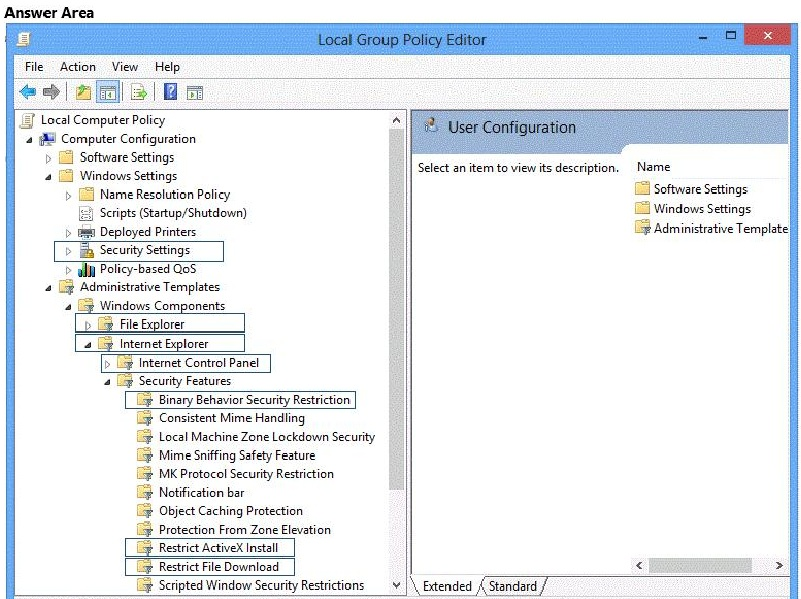
Answer : 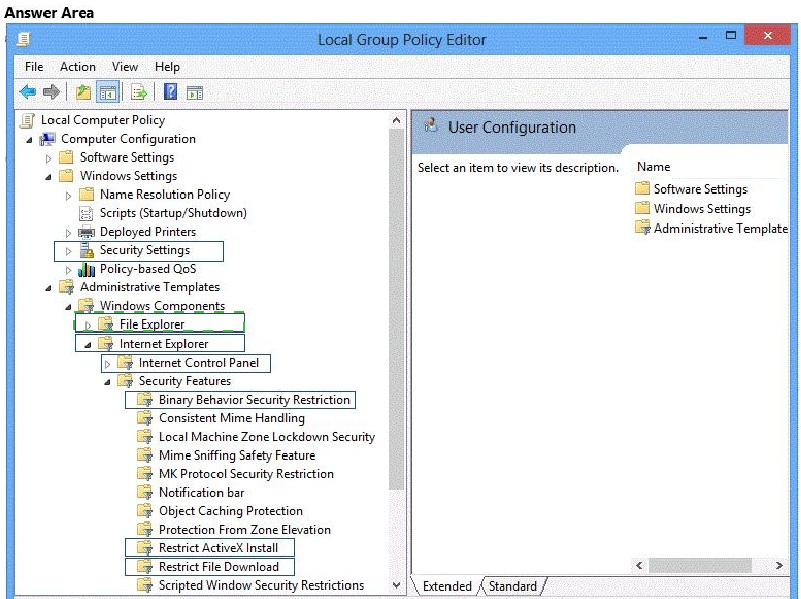
Explanation:
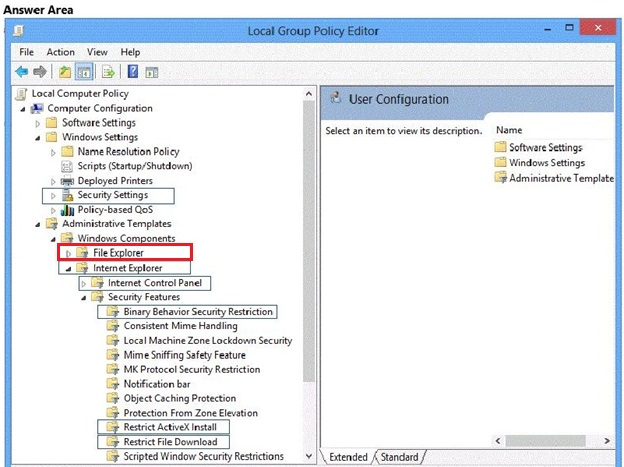
Question 7
A company has Windows 8.1 client computers. The company uses Windows BitLocker
Drive Encryption and BitLocker Network Unlock on all client computers.
Your need to collect information about BitLocker Network Unlock status.
Which command should you run?
- A. Run the BdeHdCfg command.
- B. Run the bitsadmin command.
- C. Run the BitLockerWizard command.
- D. Run the manage-bde command.
Answer : D
Question 8
A company has 20 portable computers that run Windows 7. The computers are members of a workgroup.
The company plans to upgrade the computers to Windows 8.1. You are planning a deployment strategy.
You need to ensure that users can log on to their existing accounts and access their existing data after the upgrade.
Which three actions should you perform in sequence? (To answer, move the appropriate actions from the list of actions to the answer area and arrange them in the correct order.)
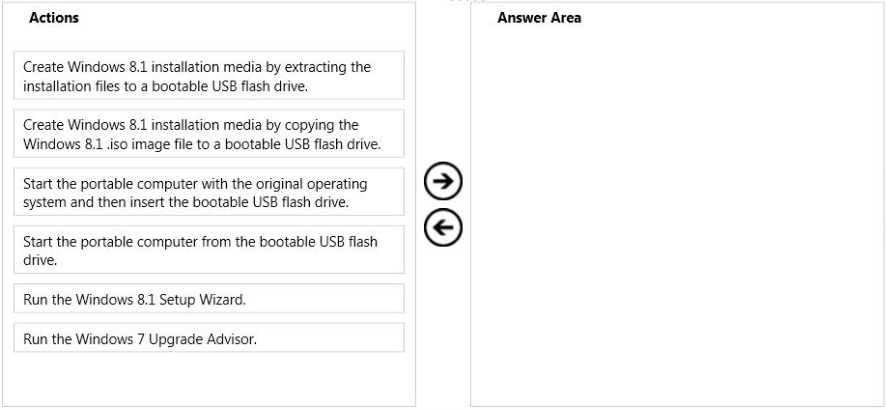
Answer : 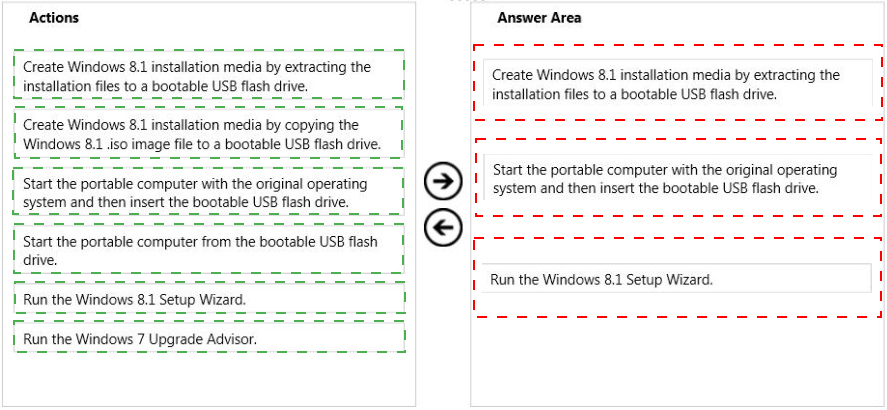
Explanation:
1. 1. Create Windows 8 installation media by extracting the installation files to a bootable
USB flash drive.
2. Start the portable computer with the original operating system and then insert the bootable USB flash drive.
3. Run the Windows 8.1 Setup Wizard.
http://winsupersite.com/article/windows8/windows-8-tip-upgrade-windows-vista-144320
Windows 8 Tip: Upgrade from Windows Vista
Continuing a series of tips that examines upgrading from previous versions of Windows to
Windows 8, I take a look at Windows Vista: Which upgrade types are supported, and what can you bring forward from this version of Windows to Windows 8?
You may recall from previous articles, or from Windows 8 Secrets, that Microsoft has changed the way they describe the processes by which we move from the one version of
Windows to the next. In the past, we used the following terms to describe the different ways in which you could install Windows:
Clean install, where you installor reinstallWindows from scratch.
In-place upgrade, where you upgrade to a newer version of Windows from within the older version, retaining most of your settings and applications, and all of your documents and other data files. Migration, by which Setup backs up your settings and/or data first, then clean installs Windows, and then reapplies your settings and/or data to the new OS.
Question 9
You have a Windows 8.1 Enterprise client computer named Computer1.
The Storage Spaces settings of Computer1 are configured as shown in the following exhibit. (Click the Exhibit button.)
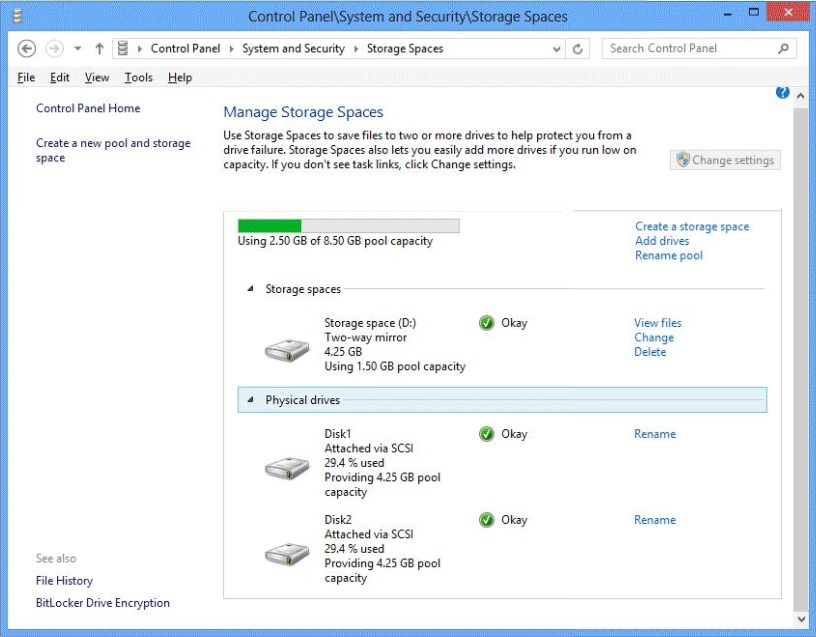
You plan to create a three-way mirror storage space in the storage pool and to set the size of the storage space to 50 GB.
You need to identify the minimum number of disks that must be added to the storage pool for the planned mirror.
How many disks should you identify?
- A. 1
- B. 3
- C. 4
- D. 5
Answer : B
Question 10
Your company plans to deploy Windows 8.1 Enterprise to all client computers.
Users in the development department and the sales department will each receive a laptop that runs a corporate image of Windows 8.1 Enterprise.
In addition to running the corporate image of Windows 8.1 Enterprise, the users have the requirements described in the following table.

You need to recommend the appropriate technology for each department.
What should you recommend? (To answer, select the appropriate technology for each department in the answer area.)
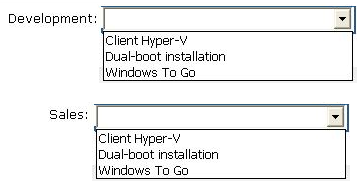
Answer : 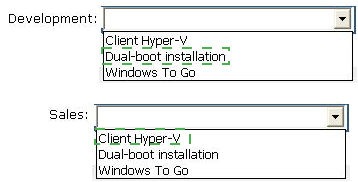
Explanation:
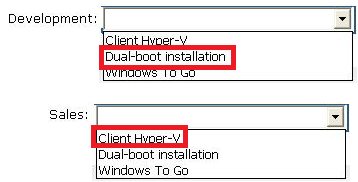
Question 11
You manage computers that run Windows 8.1.
You plan to install a desktop app named App1 on one of the client computers.
You need to install the app without any user interaction and without displaying a progress bar.
Which command should you run?
- A. msiexec /i appl.msi /qb
- B. msiexec /x appl.msi /qn
- C. msiexec /i appl.msi /qn
- D. msiexec /x appl.msi /qb
Answer : C
Explanation:
http://technet.microsoft.com/en-us/library/cc759262(v=ws.10).aspx
Msiexec (command-line options)
Provides the means to install, modify, and perform operations on Windows Installer from the command line.
/i installs or configures a product
/qn displays no user interface
Further information:
/x uninstalls a product.
Question 12
You are a system administrator for a local construction company. The company uses
Windows 8.1 Pro desktop and laptop computers. All desktop computers have a 160 GB disk drive.
You receive a call from a user who needs to a recover an .avi file from file history but discovers that the file no longer exists. The user reports recently deleting a large
PowerPoint presentation from the hard drive.
The user's File History configuration is displayed in the graphic below:
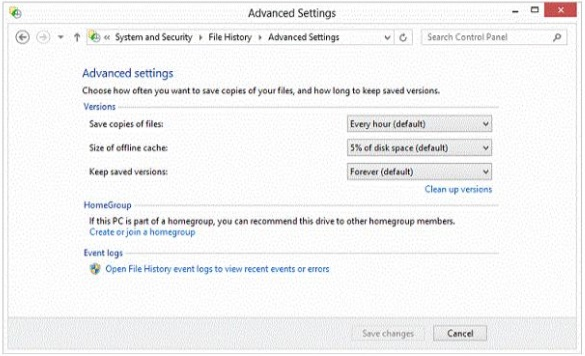
Use the drop-down menus to select the answer choice that completes each statement.
Each correct selection is worth one point.

Answer : 
Explanation:

C:\Users\Chaudhry\Desktop\1.jpg -
http://windows.microsoft.com/en-us/windows-8/what-something-goes-wrong-file-history
What if something goes wrong in File History?
Note -
File History doesn't automatically delete versions of files older than the time interval you choose unless your drive is getting full and space is needed to back up more recent versions. http://windowssecrets.com/top-story/understanding-windows-8s-file-history/
Understanding Windows 8s File History
As noted, File History typically requires a second drive or networked drive to store backup files. If that drive isnt available say, youre on the go and youve disconnected your USB drive File History will use a temporary offline cache located on your C: drive.
The Size of offline cache setting controls how much of your C: drive will be used to store temporary backups if the normal backup drive isnt available. The cache is normally set to 5 percent of the C: drives space. But you can increase the cache size to as much as 20 percent (see Figure 6).
Question 13
You administer Windows 8.1 Enterprise computers in your company network. You provide remote employees with a Windows To Go workspace.
A remote employee informs you that his workspace requires activation.
You need to activate the workspace.
What should you do?
- A. Instruct the employee to run Windows Update from the workspace.
- B. Instruct the employee to connect to the company network from the workspace by using VPN.
- C. Instruct the employee to run the slmgr /upk command from the workspace.
- D. Give the employee a Multiple Activation Key (MAK).
Answer : B
Explanation:
http://technet.microsoft.com/en-us/library/jj592680.aspx#wtg_faq_roamact
Windows To Go: Frequently Asked Questions
Do I need to activate Windows To Go every time I roam?
No, Windows To Go requires volume activation; either using the Key Management Service
(KMS) server in your organization or using Active Directory based volume activation. The
Windows To Go workspace will not need to be reactivated every time you roam. KMS activates Windows on a local network, eliminating the need for individual computers to connect to Microsoft. To remain activated, KMS client computers must renew their activation by connecting to the KMS host on periodic basis. This typically occurs as soon as the user has access to the corporate network (either through a direct connection on- premises or a through remote connection using DirectAccess or a virtual private network connection), once activated the machine will not need to be activated again until the activation validity interval has passed. In a KMS configuration the activation validity interval is 180 days.
Further Information:
http://technet.microsoft.com/en-us/library/dn502540.aspx
Slmgr.vbs Options for Volume Activation
Table 2. Slmgr.vbs command-line options
/upk [ActivationID]
This option uninstalls the product key of the current Windows edition. After a restart, the system will be in an Unlicensed state unless a new product key is installed.
Optionally, you can use the [Activation ID] parameter to specify a different installed product.
This operation must be run from an elevated command prompt.
Question 14
A company has 10 Windows 8.1 client computers. You purchase a Windows Store app and install the app on several computers.
The hard drive of a computer on which the application is installed fails. You reinstall
Windows 8.1.
You need to reinstall the Windows Store app on the computer.
Which three actions should you perform in sequence? (To answer, move the appropriate actions from the list of actions to the answer area and arrange them in the correct order.)
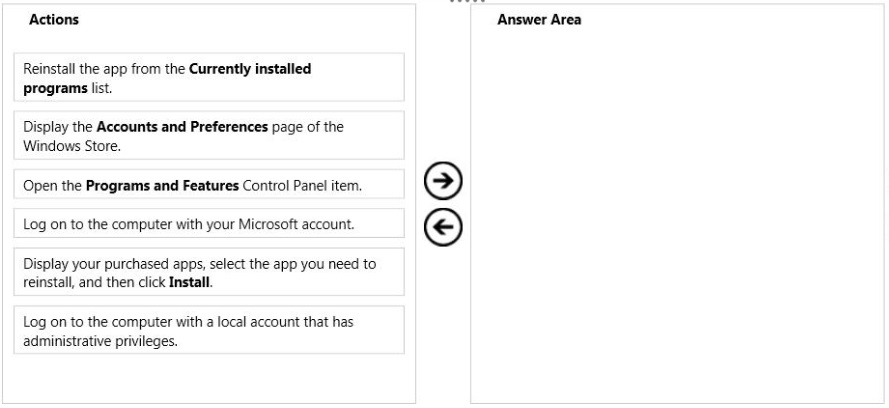
Answer : 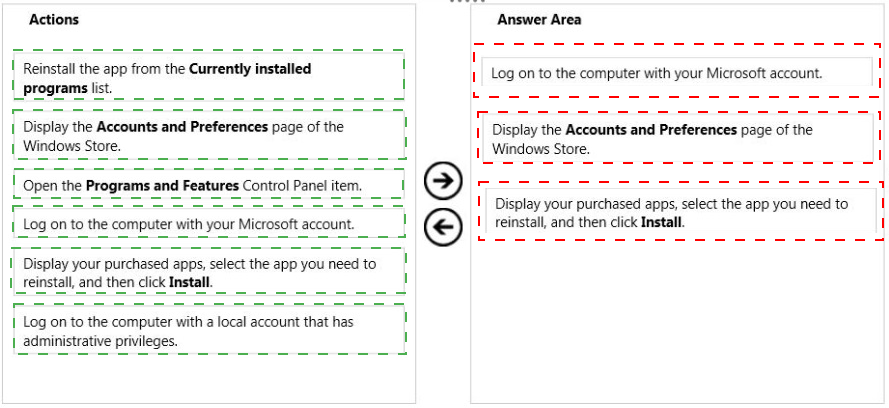
Explanation:
1. Log on to the computer with your Microsoft account.
2. Display the Accounts and Preferences page of the Windows Store.
3. Display your purchased apps, select the app you need to reinstall, and then click Install. http://windows.microsoft.com/en-us/windows-8/windows-store-install-apps-multiple-pcs
Use your Microsoft account to install apps on multiple PCs
You can use your Microsoft account to sign in to the Windows Store and install your apps on different PCs.
To install your apps on another PC
1. Sign in to the PC you want to install your apps on using your Microsoft account.
2. On the Start screen, tap or click Store to open the Windows Store.
3. Tap or click Account, and then tap or click My apps.
4. Swipe down on or right-click the apps you want to install, and then tap or click Install.
Question 15
You manage computers that run Windows 8.1.
You plan to install a desktop app named MarketingApp on one of the client computers.
You need to display a progress bar to the user while installing the app.
Which command should you run?
- A. msiexec /i marketingapp.msi /qn
- B. msiexec /x marketingapp.msi /qb
- C. msiexec /x marketingapp.msi /qn
- D. msiexec /i marketingapp.msi /qb
Answer : B